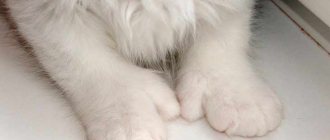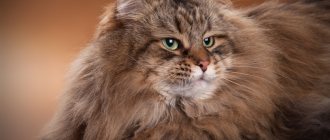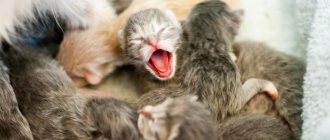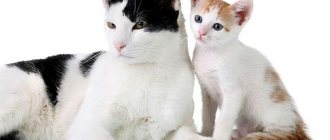Cat anatomy
Cat paws have their own anatomical features:
- Fingers . According to the standards, the front paws of cats have 5 toes, and the hind paws have 4. The 5th is located slightly higher and away from the rest. It is not involved in walking, but is important for climbing and provides a tighter grip. All fingers move independently of each other, allowing the animal to overcome various obstacles and maintain stability. Each finger consists of three bony phalanges and ends with a movable claw in the form of a sharp hook.
- Claws . Cat claws are usually called retractable, although their natural position at rest and when walking and running is inside personal leather pouches. The extension of the claws is carried out by the coordinated work of the muscular-ligamentous apparatus of the fingers. The clawed paw is necessary for capturing prey, defending against enemies, and vertical climbing.
- pads. Cats have an extremely developed sense of touch due to the high sensitivity of the pads, permeated with nerve endings. When moving, the animal not only feels the texture of the surface and its temperature, but even the slightest vibrations created, for example, by swarming mice. Between the fingers there are special sensitive hairs, similar to the vibrissae on the muzzle.
The structure and functions of a cat's claws
Tendons provide the process of stretching the claws
The cat's limbs have five fingers that end in claws. The extreme phalanges of the fingers are covered with curved keratinized tips - claws. The claws are smoothly retracted into the skin pouches, thanks to the tendons responsible for this process. The ability to retract the claws allows them not to touch the floor and not get worn down while walking.
“The lightness of a cat’s gait is explained by the fact that there are sensitive leather pads on its paws.”
The cat's limbs have leather pads that allow her to walk silently. They are equipped with highly sensitive nerve endings and blood vessels. In addition, these pads contain sweat glands that are absent on the rest of the body. The purpose of these glands is to mark their territory. So, when a cat scratches any surface, it leaves droplets of its sweat on it.
Claws allow animals to grab prey and also use them in defense.
If there are more fingers...
In addition to “normal” ones, there are cats on the planet with a total number of toes of more than 18.
An increase in the number of digits on the limbs of animals is called polydactyly.
Among cat breeds, this trait is quite common in Maine Coons.
Cause. Polydactyly is a congenital anatomical anomaly transmitted from parents to offspring by a recessive gene. If there are few extra toes, they “grow” on the front paws. It is not uncommon to find cats with six-toed forelimbs with a standard number of toes on the hind limbs, and individuals with 6 toes on the front and 5 toes on the hind.
Mutation statistics. For a multi-toed kitten to be born, the polydactyly gene must be present in at least one of the parents. In this case, the probability of polydactyly occurring is 40-50%, meaning approximately every second kitten in the litter may have extra toes. In a polydactyed pair, more than 70% of kittens are born polydactic.
Dependence on gender.
The polydactyly gene does not depend on the sex of the kitten; both boys and girls can be polydactyly with equal probability.
How to prevent furniture from being damaged by claws?
You should not punish an animal for trying to ruin another chair or sofa. It will not understand and will accept the punishment as an unjustified oppression of its right to freedom. Sharpening claws is a primal instinct. It is better to adapt to it than to regularly traumatize the animal’s psyche. Today there are many scratching posts of original design, made of various materials. They will fit perfectly into any interior, and the cat will be happy to use them without stressing your furniture and nervous system.
Types of polydactyly in cats
Phenotypic manifestations of polydactylism are varied:
- Fully functional and full-size extra fingers . With this structure, the extra fingers are fully formed, move voluntarily under the control of the brain, and have bony phalanges with joints, a pad and a claw.
- Physically underdeveloped, deformed extra fingers . In this case, the lateral fingers are thin, shortened, curved with the presence of additional phalanges. Sometimes there is a whole additional bone structure, similar to the fork of the branches and comparable in area to the main group of fingers. For example, from one full-sized additional finger grows a thin, curved one with two additional phalanges.
- Bone outgrowth . A similar defect is revealed by palpation of the paw and on an x-ray, representing an additional tubercle on the bone of one of the fingers.
- Additional claw . Between fully functional fingers there may be free claws that are not controlled and not retractable, and therefore dangerous for the animal itself. With extra thumbs they talk about preaxial polydactyly, with extra little fingers - postaxial. In cats, the most common form is the preaxial form: in appearance, this paw resembles a mitten.
Number of toes a cat has
Most representatives of the cat family have 18 toes on four paws. These soft but durable springy limbs can hardly be called “fingers”. Rather, these are “pads” with sharp claws that play an important role for the cat’s active lifestyle: climbing trees, running, even catching prey. So, have you managed to find out how many fingers with claws your beloved member of the household has?
Classic 18 is a standard recognized and approved by international felinological organizations: WCF, TICA, and others. However, some cat breeds have up to 8 toes on each paw or several. This phenomenon is called polydactyly and is caused by gene mutations. In Europe and Russia, such cats are rare, but in the vastness of North America they are a common occurrence.
And what about Ernest Hemingway's famous cats? The descendants of the writer's six-fingered favorite named Snowball are in special demand: beliefs say that these beauties bring good luck and happiness to the home. Wide paws and sharp claws help polydactyl cats move more easily in the snow. Many believe that a developed finger makes it possible to grasp objects, and an increased number of claws makes it better to climb trees.
Since the beginning of the 19th century, polydactyl cats, or “Poly” as they are called, have enjoyed special honor and respect from sailors and traders crossing the oceans on ships. If one of the parents is a carrier of such a gene, then the probability of having “extra” fingers increases to 60%. Felinologists say that no matter how many fingers or claws your beloved cat has, the “ability”, the tendency to scratch hard surfaces, is influenced by:
- Raised by a cat mother. If the latter is accustomed to sharpening her claws on a scratching post (claw table), then she will teach her children to do the same.
- A specially designated place (scratching post, piece of wood) for the cat.
- Regular procedures for trimming nails and sharpening them with a nail file.
Famous multi-toed cats
Some cat lovers consider multi-toed paws cute and try to buy an unusual pet for their home, even for a lot of money. Other people associate this mutation with deformity.
The Guinness World Book of Records contains records of many unusual animals, including polydact cats. The winner in this category is still the cat with 32 toes, born in 1974 (read more about the Guinness World Records for cats). Since 2002, the championship has passed to a multi-fingered cat named Jake, who lives with Michelle and Paul Contant from the Canadian city of Ontario. The wonderful beast has 7 fingers on each paw.
Why do pets need claws?
Cats are very cute and funny pets that provide a lot of fun to their owners. Loving owners are always concerned about the health of their pets. Therefore, they are interested in every little detail, for example, how many claws cats have.
Many people do not know how many claws a cat has, that is, there are several opinions on this matter - some believe that a cat has 20 claws, others that 18. Of course, the easiest way is to take your cat in your hands and count the number of claws on its paws - 18 there will be a correct answer, since there are only 4 claws on the hind legs.
But no matter how many claws there are, the main thing is to properly care for them. This is important because if the claws are left unattended, the result will be shabby and scratched furniture. This is why it is very important to trim claws on time.
Multi-toed celebrity cats
History records the names of famous people who became owners of polydact cats:
- Captain Gray's Red Lizzie was a renowned rodent exterminator on a ship that made regular raids into New England. At that time, polydactic cats were considered good luck talismans among sailors, since they were more skillful at catching rats, more dexterous in climbing edges, and better balanced on an unstable deck. This maritime tradition contributed to the popularization of “cats in mittens” and the emergence of their lovers everywhere.
- The six-toed cat Snowball was given by the sea captain to the American writer Ernest Hemingway and became his pride.
- For many years, the polydactyl cat Slippers lived in the apartment of US President Theodore Roosevelt, accompanying his owner at official events.
Deviations from the norm
Deviations from the norm in the development of cat fingers are a common occurrence. Polydactyly in cats is called polydactyly (from Greek: poly = many, daktulos = fingers). The record number of toes on a cat's paws was recorded in October 1974 - as many as 32 toes!
Polydactyly can be postaxial or preaxial. With postaxial polydactyly, the fingers are arranged in one row. With preaxial, additional toes grow on the inside of the paws.
The first record of feline polydactyly dates back to 1868. Cats with this feature quickly gained attention and interest. Sailors fell in love with polydact cats and took them with them on their trips. It was believed that the six-fingered fluffy traveler would bring good luck to the ship and protect it from sea troubles. In addition, the sailors believed that the many-toed cat would make a good rat hunter.
Multi-toed cats are sometimes called ship cats
Cats with polydactyly are called Hemingway cats. The house of the famous writer was filled with fluffy purrs, among which was a six-fingered cat. And Theodore Roosevelt's polydactyl favorite became one of the first cats to live in the White House.
Polydactyly and health
According to available information, polydactyly does not lead to serious health problems in pets, however, according to the testimony of felinologists:
- polydactyl kittens begin to walk somewhat later than their “normal” littermates, since it is more difficult for them to cope with the peculiarity of the musculoskeletal system;
- Multi-toed cats have heavier and wider bones, leading to increased body weight and increased stress on the heart and joints;
- with a large number of additional fingers and significant “branchiness” of such a structure, a pathological redistribution of the load on the limb occurs during support and movement;
- the operation to remove dewclaws is very complicated;
- an uncontrolled free claw can be dangerous.
Purpose
Claws are vital for a cat, whether the pet is domestic or lives in the wild. Nature intended that with their help the animal obtains and cuts up food, defends itself and protects itself, and climbs onto the necessary surfaces.
The modern domestic cat also actively uses them. Of course, she doesn’t need to get food on her own. But instincts force her to sharpen them, thereby the keratinized cells fall off and the pet marks the territory, leaving a smell.
In addition, claws are an essential element in the structure of the skeleton; with their help, the animal feels balance and orients itself in space. Thanks to them, animals land softly and do not injure their limbs.
Claws play an important role in the musculoskeletal system.
Permission to breed
Since 2008, there has been a campaign to recognize multi-toed Maine Coons, and many organizations (CFA, TICA, CFF, ACFA) confirm their club status. This is happening against the backdrop of the growing popularity of the breed and increased interest in such cats among lovers.
Breeders who specialize in breeding Maine Coons with the mutation should be aware that it is caused by a gene passed directly from the parents. After a generation, this mechanism does not work.
Only the presence of a parent with polydactyly in mating allows one to expect offspring with an unusual paw structure. This is only 40-50% of the cubs, which makes kittens with this feature exotic.
Admission to breeding maine coon polydact is issued, in addition to the above organizations, by the American TICA and the New Zealand NZCF. The pedigree of mutation carriers must include the letter P (or Pd - designation of the polydactyl gene).










